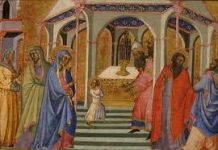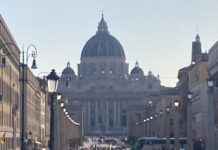The See of Ravenna – on the north-east coast of Italy – was once, way back in the Middle Ages, nearly on par with Rome in terms of its ecclesiastical stature. Of course, Rome was and is always Rome, and the Pope, the Pope, who is always, unto the end of time, the Bishop of Rome.
By tradition, the first said Bishop of Rome, Saint Peter himself, is said to have appointed one of the first bishops of Ravenna, Saint Apollinaris, whom we celebrate today. Not much is known for certain about the good bishop, except that he suffered much – one might read the numerous beatings and tortures he was said to have undergone, as recounted in the Catholic Encyclopedia – and was martyred for the Faith likely under the reign of Vespasian (+79), or perhaps, if the direction connection to Saint Peter be discounted, even Septimius Severus (+211).
Saint Peter Chrysologus (+450), who succeeded as Bishop of Ravenna centuries later (and whom we celebrate later this month), owed his own vocation in part to a vision from Saint Apollinaris. He had this to say of the early bishop martyr, which we may apply very much to ourselves:
It is not death so much as faith and dedication that make one a martyr; and just as it is a mark of virtue to fall in battle, in conflict, for the love of the king, so it is a mark of perfect virtue to engage in combat for a long time and to bring it to its conclusion. Therefore, the enemy did not make him a martyr, since he did not inflict death, but he proved him to be a martyr, because he did not remove his faith; the crafty enemy hurled the weapons that he could, and he aimed at him everything he had in his arsenal; nevertheless, he was unable to budge this bravest of leaders, nor could he tarnish his constancy. It is the highest honour, brothers, to despise this present life for the Lord’s sake, if that is necessary, but it is also glorious even while living to scorn and trample underfoot the world and its ruler.
The martyr was taken out of the liturgical calendar in the post-conciliar changes of 1969, but put back in when the Missal was revised in 2002, perhaps to give more examples of courageous bishops willing to face martyrdom for their flocks and their faith. He is also the patron saint of epilepsy, gout and, I read once if memory serves, of dentists, perhaps due to the damage his teeth suffered in those beatings.
One way or the other, we pray to the good bishop and martyr, for the Church in our own beleaguered time.











